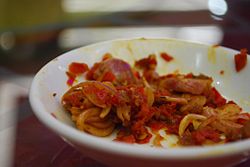 A bowl of cincalok | |
| Alternative names | Chinchalok, cencaluk, cencalok |
|---|---|
| Type | Condiment |
| Course | Appetizer or main course |
| Place of origin | Malaysia |
| Region or state | Malacca[1][2] |
| Associated cuisine | Brunei, Indonesia, Malaysia and Singapore |
| Serving temperature | hot or room temperature |
| Main ingredients | Small shrimp or krill |
Cincalok (Jawi: چنچالوق), also cencaluk, is a Malay condiment that originated in Malacca, Malaysia, consumed by Malays, Peranakans and Kristangs. Its origins can be traced back to the Portuguese occupation of Malacca. This condiment consists of fermented small shrimp or krill, which are called udang geragau in Melaka and are easily identifiable in the mixture. It is predominantly salty in taste, and is usually served together with chillis, shallots and lime juice. Sir R. O. Winstedt has written about "Cencaluk" in Malaysia in his book "The Circumstances of Malay Life - 1909".[3] This shrimp is seasonally available in Pantai Klebang, Limbongan, Tanjung Kling and several coastal areas.
Presently, cincalok making enterprises are gaining ground in several areas in the state of Melaka. The state government itself has designated the State Legislative Assembly constituency Sungai Udang as the area to produce cincalok in the 'Satu DUN Satu Produk' plan.
Apart from that, cincalok is also now easily available at roadside stalls and in the markets around the state.
The consumption of cincalok has also spread to Riau and West Kalimantan in Indonesia. It is similar to bagoong alamang (see shrimp paste) in the Philippines and khoei chalu (Thai: เคยฉลู) in Thailand.
- ^ Clark, Melissa (30 August 2006). "From Malaysia, a Pungent Ferment". The New York Times.
- ^ "Cincalok | Traditional Dip from Malacca | TasteAtlas".
- ^ The Circumstances of Malay Life, Sir Richard Olof Winstedt, Richard Winstedt, Ams PressInc, 1909 - Social Science - 90 pages
